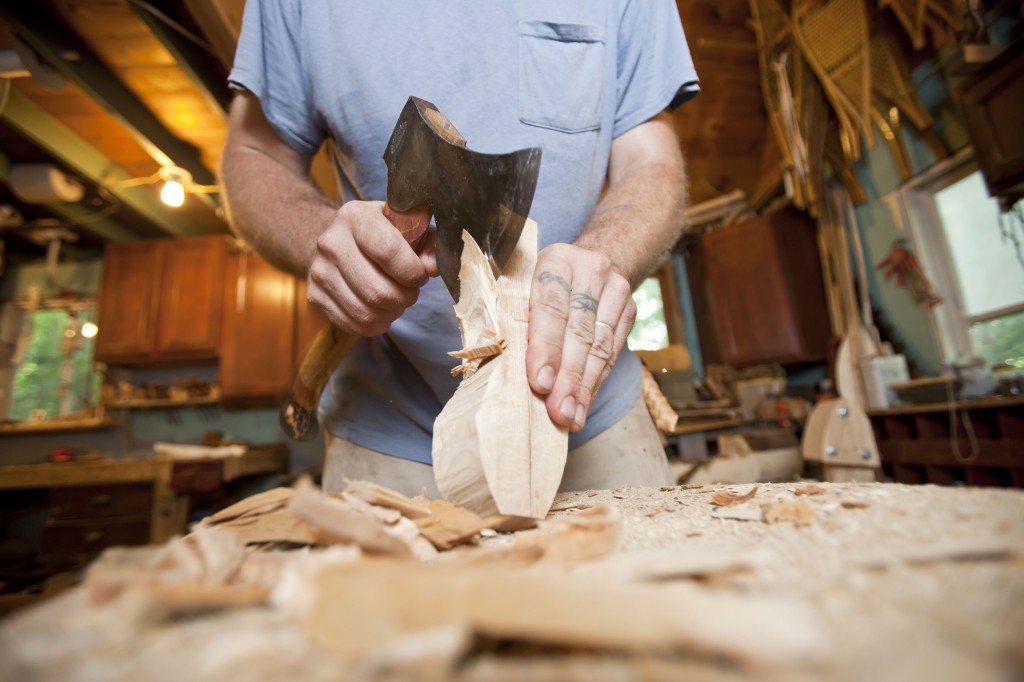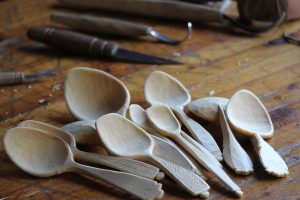We may receive a commission when you use our affiliate links. However, this does not impact our recommendations.
I caught up yesterday with Jarrod StoneDahl, a spoon carver and traditional green woodworker in northern Wisconsin. Here’s our conversation, the second installment in the “Woodworking Daily” series of Q&A posts with great minds in the woodworking community. And there’s a twist to this series – each interviewee will tell me who I should talk to next. Enjoy!

Green woodworking begins with the most basic of tools and material. Jarrod StoneDahl cuts into a new spoon, above.
Dan: What are the tools and fixtures you use for spoon carving and other green woodworking?
Jarrod: I use hand tools for most of my work, but I rough out bowl blanks with a chainsaw. The main tools I use for spoon carving are an axe, a straight-bladed carving knife (generally referred to as a Sloyd knife) and a few curved knives called hook or spoon knives. All of these have very, very old origins. For turning bowls, I use a foot-powered – or spring-pole – lathe. The tools that cut the wood while it is spinning on the lathe are referred to as hook tools. Like bowl turners of the past, I forge my own hook tools.
Dan: What is the philosophy behind your craft?

A few of Jarrod’s beautiful spoons, which he believes forge a connection between past, present and future.
Jarrod: I’ve come to believe that through the use of wooden spoons and bowls, and other handmade items, we can gain insight into the natural world and our connection to it. It’s a very direct link. These items connect us to the past, present and future. The past – our heritage or culture – is steeped with the making and using of handmade utilitarian items, like wooden spoons and bowls. In the present, these items have mostly been replaced by cheaply made “products.” The future, and my hope, is a movement back toward making and using quality handmade items – with the recognition that this not only supports local artisans and economies and carries on an age-old tradition, but also gives the user satisfaction. My friend and fellow spoon carver Barn Carder calls this the “The Wood Culture Renaissance.” I like that.
Dan: Where do you find inspiration and new ideas?
Jarrod: I find inspiration in the old Swedish and Norwegian immigrant spoons that I see in museums here in the northern Midwest. Many of these spoons are very finely made with an attention to detail and a fair amount of decoration. All of these items were made with great skill. I really enjoy pieces that were made and designed to be used daily, with just a little decoration for the eye. It could be a hand-crafted chair, a hand-thrown cup or a wooden bowl or spoon.
Dan: Who should I talk to next?
Jarrod: Talk to Jim Sannerud who is an electric lathe bowl turner from the Minneapolis–Saint Paul area. He turns really nice bowls.
Thanks, Jarrod! Green woodworking does look fun, and your approach is inspiring.
Note to readers: We have just released our latest value pack, a carving collection. So if you’re thinking about diving deeper into all types of carving, buy this one today before we run out!
–Dan Farnbach
Here are some supplies and tools we find essential in our everyday work around the shop. We may receive a commission from sales referred by our links; however, we have carefully selected these products for their usefulness and quality.











Dan, I am sure this is the start of a great series. Keep it up!
Beeing a swedish woodworker I am happy to read that Jarrod finds inspiration in old Swedish and Norwegian immigrant spoons. The film below is from 1923 and shows the making of clogs, wooden spoons and chairs, made with basic hand tools and super skills.
It also shows some nice beards and hats.
http://www.svtplay.se/klipp/98733/traskomakeri-traskedstillverkning-stolmakeri-utan-ljud-1923
Talking about spoon making, Paul Sellers had a very nice YouTube video on making a spoon – starts from a log with a few hand tools and proceeds! Made me want to go out and find a piece of limb and give it a shot myself. Wonderful (but dangerous!) to see accomplished woodworkers make this stuff look soooooo simple.
I commented to a friend about making wooden spoons and his comment was along the line of ‘..who the heck would want a wooden spoon. Certainly you could find something better to do with your time..’ Well, that set me back on my heels a bit. After thinking for a time, my conclusion is that this (e.g. making wooden spoons) is not about making a wooden spoon as it is about the creative process and artistry of making something!